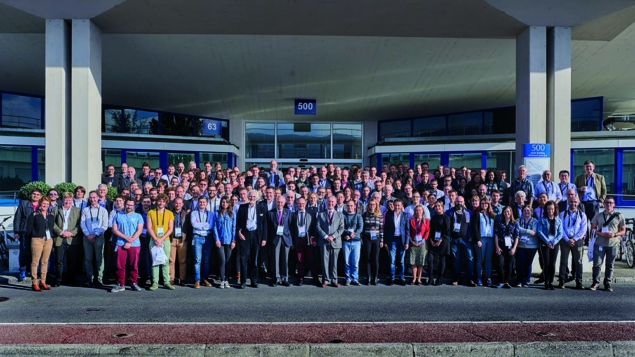
The High-Luminosity LHC (HL-LHC) has reached its halfway point. The upgrade project was launched eight years ago and is scheduled to start up in 2026, following major interventions to the CERN accelerator complex. From 15 to 18 October, representatives of the institutes contributing to the HL-HLC gathered at CERN for the 8th annual meeting of the HL-LHC to assess progress as the project moves from prototyping to the series production phase for much of the equipment.
The HL-LHC annual meeting is a chance to conduct a global review of the project. The civil-engineering work has progressed since it began in the spring: excavations have reached a depth of 30 m at Point 1 (ATLAS) and 25 m at Point 5 (CMS). The two 80 m shafts should be fully excavated by the beginning of 2019. As for the accelerator, one of the key tasks is the production of around 100 magnets of 11 different types. Some of these, notably the main superconducting quadrupole magnets that will replace the LHC’s triplets and focus the beams very strongly before they collide, are made from the conductor niobium tin, which is particularly difficult to work with. The short prototype phase is already nearing completion for the quadrupole magnets: the long (7.15 m) quadrupoles are being produced at CERN, while shorter (4.2 m) quadrupoles are being developed in the framework of the US LHC-AUP (LHC Accelerator Upgrade Project) collaboration. Several short prototypes have already reached the required intensities on both sides of the Atlantic.
New dipole magnets at the interaction points, which divert the beams before and after the collision point, are being developed in Japan and Italy. One short model has been successfully tested at the KEK laboratory in Japan and a second is in the process of being tested. INFN in Italy is also assembling a short model. Finally, progress is being made on the development of the corrector magnets at CERN and in Spain (CIEMAT), Italy (INFN) and China (IHEP), with several prototypes already tested. In 2022, a test line will be installed at CERN’s SM18 hall to test the first magnet chains.
One of the major successes of 2018 is the installation in the Super Proton Synchrotron (SPS) of a test bench with an autonomous cryogenic unit. The test bench houses two DQW (double-quarter wave) crab cavities, one of two designs under study (CERN Courier May 2018 p18). The two cavities rotated the proton bunches as soon as the tests began in May, marking a world first. The construction of the DQW cavities will continue while the second architecture, the radiofrequency dipole, is being developed in the US.
Many other developments were presented during the symposium: new collimators have been tested in the LHC; a beam absorber for the injection points from the SPS was tested over the summer and will be installed during the LHC’s second long shutdown; a demonstrator for a magnesium-diboride superconducting link is currently being validated; and studies have been undertaken to test and adjust the remote alignment of all the equipment in the interaction regions.
Over the four days that the meeting took place, some 180 presentations covered a wide range of technologies developed for the HL-LHC and beyond.







